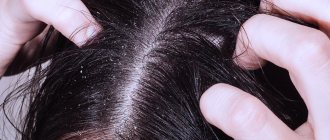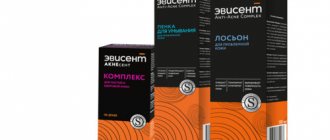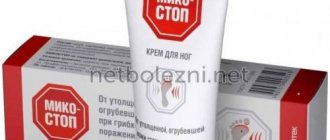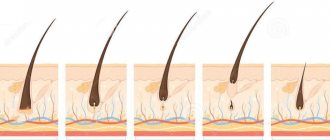Dandruff is often one of the signs of seborrhea - a disorder of the sebaceous glands. Oily dandruff on the scalp is a worrying symptom because if left untreated, a person may experience hair loss. In addition, oily seborrhea often indicates problems in various body systems: digestive, nervous, endocrine. The article will discuss these and other causes of seborrheic dermatitis (this is the name doctors use for the disease, one of the symptoms of which is oily dandruff), and will also tell you how to get rid of oily dandruff on the head.
What does oily dandruff look like?
Oily seborrhea can manifest itself in two main forms: liquid and thick, and the only common symptoms include yellow dandruff and an itchy sensation.
- Thick seborrheic dermatitis looks like the scalp is covered with a yellow crust. This occurs because the ducts of the sebaceous glands become clogged with a mixture of sebum and dead cells of the epidermis, the top layer of the skin. Then this mixture thickens, turning into a keratinized yellowish crust that begins to itch very much. Unlike dry dandruff, thick yellow scales are difficult to come off and often get tangled in the hair, and the hair itself becomes rough and tough. In some cases, due to the formation of horny plugs, pustules may develop.
- The liquid form of seborrheic dermatitis develops differently. The dilated ducts of the sebaceous glands begin to secrete excessive amounts of sebum, which leads to an unnatural shine of the hair, which, under the influence of the secretion, begins to stick together and looks as if it has been generously poured with oil. Further, due to excessive secretion and under the influence of an actively multiplying fungus, yellowish particles similar to crumbs begin to appear on the scalp and hair. This yellow dandruff causes severe itching, and the skin with liquid seborrheic dermatitis looks like an orange peel. However, the appearance of hair and the sensation of itching are not the only and not the main problems of the liquid form of seborrheic dermatitis. If you do not start treating this disease, after a while acne and boils will begin to appear in places where yellow dandruff accumulates, and then hair will fall out. (1)
How to treat pathology?
Oily seborrhea is eliminated using conservative methods. They involve the use of drugs for internal and external use.
To treat forms of seborrhea, drug therapy is prescribed.
It includes:
- vitamin complexes;
- immunomodulators;
- antimycotic and other agents.
Patients are prescribed antifungal, antibacterial, and exfoliating drugs for seborrhea. If the pathology covers a large area of skin, ointments and creams must be prescribed. Particular attention is paid to physiotherapeutic procedures, including:
- cryomassage of the head;
- laser therapy;
- ozone therapy, etc.
Oily seborrhea of the scalp should be treated comprehensively! Only in this case is it possible to achieve the desired effect.
Seborrhea of the head is treated with diet. Patients are advised to avoid fried and spicy foods, sweets, white bread, and coffee. You should add porridge, seaweed, dietary fish and meat to your diet.
Important! Treatment is carried out exclusively under the supervision of the attending physician. He regularly monitors the condition of the epidermis of the head and hair, and adjusts therapy if necessary.
Causes of seborrheic dermatitis
Oily yellow dandruff is dead particles from the scalp mixed with sebum and fungal waste products, which cause itching. The Malassezia fungus also reproduces in healthy skin, but its content in sebum does not exceed 50%. (2). If too much secretion is produced, this creates favorable conditions for the growth of fungus, and when its amount reaches 74%, dandruff appears and the skin begins to itch. And when the level of Malassezia in sebum is 83%, seborrheic dermatitis begins and oily yellow dandruff appears. However, an excessive amount of Malassezia in sebum, as well as increased secretion of the sebaceous glands, are only consequences caused by deeper causes. The mechanisms leading to the occurrence of seborrheic dermatitis are not yet fully understood, but it is known that this pathology can be caused by the following reasons.
- Various diseases. These include diseases of the gastrointestinal tract, genitourinary and endocrine systems. The fact is that diseases of this type can affect the functioning of various secretory organs, including the sebaceous glands of the head.
- Genetic predisposition. The hereditary factor is the only reason that does not allow you to get rid of seborrheic dermatitis completely, therefore, in this case, subsequent prevention of the disease is also very important.
- Hormonal changes. Increased production of sebaceous gland secretions can cause a hormonal imbalance in the body, or more precisely, an excess of male hormones. This happens when taking certain medications, and oily dandruff is also observed in adolescents during puberty. For most, it goes away before the age of 25, but 10% of young people will require treatment for seborrheic dermatitis (3), and it is advisable to start it immediately, otherwise there will be a risk of early hair loss.
- Frequent stress. A person’s psycho-emotional state significantly affects his health, and people living in constant stress are vulnerable to many diseases, including seborrheic dermatitis.
- Ecological problems. If a person lives in an industrial center, near busy highways, and acid rain periodically pours from the sky, this often leads to the appearance of not only seborrheic diseases, but also much more dangerous diseases, for example, cancer.
- Poor nutrition. The disease can occur with excessive consumption of fatty foods, and it can also be triggered by frequent consumption of spicy foods. Such food provokes the sebaceous glands to produce excess amounts of secretion, creating favorable conditions for the proliferation of pathogenic fungus.
- Dry seborrhea. In some cases, dry seborrhea can lead to seborrheic dermatitis, so in order to maintain healthy hair, it is important to start fighting dry dandruff.
Popular questions
1. Is it possible to dye your hair if you have dry seborrhea?
Dyeing your hair for dry seborrhea is not recommended, especially during an exacerbation. As a result of the disease, the hair is already weakened and prone to loss, and after dyeing with permanent dye, this process may worsen. Aggressive substances in hair dye can increase dryness and flaking of the scalp. It is better to first contact a trichologist and undergo treatment for dry seborrhea.
2. What to do if seborrhea does not go away?
Seborrhea is a chronic disease that cannot be completely cured. But proper therapy and compliance with doctor’s recommendations can prolong periods of remission. If exacerbations of seborrhea occur frequently, you need to consult a doctor (dermatologist or trichologist) to correct the treatment regimen.
3. Is seborrhea contagious?
The contagiousness of seborrhea is a myth. The disease develops under the influence of internal factors (immunological, neurological diseases, stress and others).
0
0
1
Article rating:
4.57 out of 5 based on 7 ratings
Author: Rozhkova Natalya Viktorovna
Dermatovenerologist, trichologist. Highest category. Work experience over 25 years.
What to do if you have oily dandruff on your head?
Any dandruff causes inconvenience to a person, especially oily dandruff, so it is advisable to start treatment immediately after detecting scales on the head. There are many remedies that fight seborrheic dermatitis with varying degrees of effectiveness, and recently oily dandruff has been treated with the antifungal drug ketoconazole. It suppresses the development of colonies of the Malassezia fungus, eliminating the dandruff it causes. (4)
In addition, oily dandruff can serve as an indicator of the presence of concomitant diseases of the digestive, genitourinary, endocrine systems, as well as skin diseases (for example, pityriasis versicolor and various types of dermatitis). Therefore, it is advisable to undergo an examination, which is the key to recovery from seborrheic diseases, since it can identify other diseases and thus eliminate the cause of oily dandruff.
Seborrhea is contagious
Seborrhea is not contagious, so you should not avoid communicating with people who have dandruff or seborrhea on their faces. If everything is in order with your immunity and the functioning of the sebaceous glands, then even if fungi of the genus Malassezia come into contact with your skin, nothing will happen. This fungus is already constantly present on your skin without causing problems.
Therefore, neither the use of a common comb, nor a hat, nor a towel threatens your health if you do not have a predisposition to seborrheic dermatitis and a strong immune system. Seborrhea is also not transmitted by airborne droplets, touching the head or shaking hands.
Treatment for oily scalp and dandruff
You need to be able to distinguish between oily skin and oily seborrhea, since it happens that an excess amount of sebum is produced, but this does not lead to the occurrence of the disease. The signs of seborrhea are as follows:
- the presence of dandruff, which comes in different colors, and in the case of seborrheic dermatitis - yellow and greasy;
- frequent itching in places where large colonies of the Malassezia fungus are present (Malassezia waste products cause this itching);
- hair loss, often in certain places - in this case they talk about alopecia areata;
- The skin is not smooth to the touch; when palpated, you can feel that it is covered with a crust. (5)
If there are no these symptoms, but the hair quickly becomes dirty and looks as if it has been smeared with oil, then the person simply has oily skin: the sebaceous glands produce a lot of sebum, but this does not lead to the development of seborrhea. We will not consider the problems of oily skin, but will talk about how to treat oily dandruff. The following remedies help fight seborrheic dermatitis:
- preparations based on sulfur and zinc, regulating the secretion of the sebaceous glands;
- antifungal drugs that destroy Malassezia colonies and suppress further growth of the fungus (ketoconazole);
- hormonal drugs (for example, isotretinoin) that reduce the production of androgenic hormones, which in turn affect the activity of the sebaceous glands. This treatment for severe forms of seborrheic dermatitis is recommended mainly for women, since a decrease in the production of androgens can have a negative effect on the male body;
- folk remedies. To treat dandruff, decoctions of herbs such as celandine, nettle, calendula, plantain, sage, chamomile, coltsfoot, and yarrow are still used. They also use essential oils, various masks (from chicken eggs, lemon, onions), wash their hair with tar and laundry soap, rub with apple cider vinegar (table vinegar cannot be used!), rub in salt (not recommended, since salt is a strong irritant, and in the end it will only lead to worsening seborrhea).
Diagnostics
The symptoms of seborrheic dermatitis are similar to atopic dermatitis, psoriasis, and allergies. To make an accurate diagnosis, you need to consult a specialist. Consultations with a neurologist, gastroenterologist, and endocrinologist may be necessary.
To diagnose this disease, it is necessary to examine the biochemical composition of the blood and hormonal levels. If necessary, ultrasound examination of internal organs, spectral analysis of hair, and skin dermatoscopy are prescribed. A comprehensive diagnosis will help identify the causes of seborrheic dermatitis and prescribe the correct treatment.
Prevention of oily seborrhea
If it is impossible to eliminate the cause of oily dandruff (for example, with a genetic predisposition to the disease), regular prevention comes to the rescue. The most effective is comprehensive prevention, the mandatory components of which should be:
- proper nutrition. Food rich in vitamin A will help you (carrots all year round, and blueberries in summer), but it is better to eat as little fatty and spicy foods as possible, and also eat less fried foods;
- proper hygiene. It is usually not recommended to wash your hair either too often or too rarely, but if you have oily dandruff, washing your hair daily won’t hurt. It is only important to choose a suitable shampoo that will not irritate the skin and will not provoke the growth of fungus. You also need to air your head and walk without a hat whenever the weather permits;
- medicated shampoo with antifungal components ketoconazole, which is used periodically in courses.
SKIN-CAP products
Modern clinical research [2] in the field of dermatology indicates the positive effect of products based on activated zinc pyrithione in the treatment of seborrhea - shampoo and aerosol SKIN-CAP.
The use of the products helped to eliminate the symptoms that bothered patients within 1-2 weeks of use [2].
The SKIN-CAP line includes medications in the form of cream, aerosol and shampoo; as well as skin care cosmetic product Skin-cap shower gel.
All forms of this drug are characterized by:
- High antimicrobial, antifungal and anti-inflammatory activity, due to which SKIN-CAP not only helps in relieving symptoms, but acts directly on the cause of these symptoms;
- High level of safety [4], thanks to which SKIN-CAP cream and aerosol are recommended for use by all categories of adults and children from 1 year of age [3];
- Wide choice of forms - the drug is available in 3 forms, which means that the doctor can easily select a flexible individual treatment regimen for a patient with any type of seborrhea in different parts of the body.
Shampoos with zinc against seborrhea
Today, shampoos with zinc are very popular. More than a hundred brands produce shampoos with zinc to eliminate dandruff and seborrhea.
- SKIN-CAP shampoo is an original treatment based on activated zinc pyrithione, a substance with pronounced antimicrobial, anti-inflammatory and antifungal activity. The skin cap contains activated zinc pyrithione in a proportion of 1 g per 100 ml of the drug. Suitable for combating dry and oily seborrhea, dandruff and seborrheic dermatitis.
- Friederm Zinc is a cosmetic product based on zinc pyrithione. Contains a suspension of zinc pyrithione at the rate of 20 mg of active substance per 1 ml of shampoo. Helps eliminate dandruff, but is not therapeutic.
- Keto plus Keto plus is a medicinal antifungal shampoo. 1 ml of the drug contains two active components: pyrithione zinc (10 mg) and ketoconazole (20 mg). Keto plus is used for the treatment and prevention of scalp skin diseases such as pityriasis versicolor, seborrheic dermatitis, and dandruff.
- Cynovit Shampoo Cynovit is a cosmetic product used to combat dandruff on the head. It is recommended to wash your hair up to 2-3 times a week. The duration of the course is 1 month.










